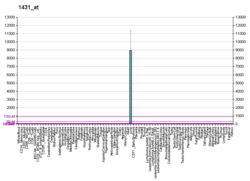
Back سيتوكروم 2إي1 Arabic سيتوكروم 2اي1 ARZ CYP2E1 Welsh CYP2E1 Spanish Sitokrom P450 2E1 ID CYP2E1 Portuguese CYP2E1 Ukrainian
Cytochrome P450 2E1 (abbreviated CYP2E1, EC 1.14.13.n7) is a member of the cytochrome P450 mixed-function oxidase system, which is involved in the metabolism of xenobiotics in the body. This class of enzymes is divided up into a number of subcategories, including CYP1, CYP2, and CYP3, which as a group are largely responsible for the breakdown of foreign compounds in mammals.[5]
While CYP2E1 itself carries out a relatively low number of these reactions (~4% of known P450-mediated drug oxidations), it and related enzymes CYP1A2 and CYP3A4 are responsible for the breakdown of many toxic environmental chemicals and carcinogens that enter the body, in addition to basic metabolic reactions such as fatty acid oxidations.[6]
CYP2E1 protein localizes to the endoplasmic reticulum and is induced by ethanol, the diabetic state, and starvation. The enzyme metabolizes both endogenous substrates, such as ethanol, acetone, and acetal, as well as exogenous substrates including benzene, carbon tetrachloride, ethylene glycol, and nitrosamines which are premutagens found in cigarette smoke. Due to its many substrates, this enzyme may be involved in such varied processes as gluconeogenesis, hepatic cirrhosis, diabetes, and cancer.[7]
- ^ a b c GRCh38: Ensembl release 89: ENSG00000130649 – Ensembl, May 2017
- ^ a b c GRCm38: Ensembl release 89: ENSMUSG00000025479 – Ensembl, May 2017
- ^ "Human PubMed Reference:". National Center for Biotechnology Information, U.S. National Library of Medicine.
- ^ "Mouse PubMed Reference:". National Center for Biotechnology Information, U.S. National Library of Medicine.
- ^ Lewis DF, Lake BG, Bird MG, Loizou GD, Dickins M, Goldfarb PS (Feb 2003). "Homology modelling of human CYP2E1 based on the CYP2C5 crystal structure: investigation of enzyme-substrate and enzyme-inhibitor interactions". Toxicology in Vitro. 17 (1): 93–105. doi:10.1016/s0887-2333(02)00098-x. PMID 12537967.
- ^ Rendic S, Di Carlo FJ (1997). "Human cytochrome P450 enzymes: a status report summarizing their reactions, substrates, inducers, and inhibitors". Drug Metabolism Reviews. 29 (1–2): 413–580. doi:10.3109/03602539709037591. PMID 9187528.
- ^
 This article incorporates public domain material from "CYP2E1 cytochrome P450 family 2 subfamily E member 1 [ Homo sapiens (human) ]". Reference Sequence collection. National Center for Biotechnology Information.
This article incorporates public domain material from "CYP2E1 cytochrome P450 family 2 subfamily E member 1 [ Homo sapiens (human) ]". Reference Sequence collection. National Center for Biotechnology Information.
© MMXXIII Rich X Search. We shall prevail. All rights reserved. Rich X Search







